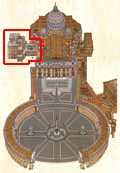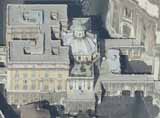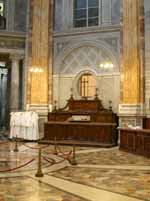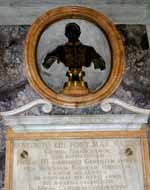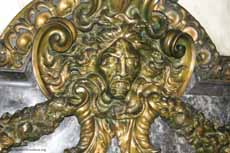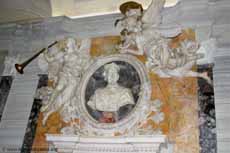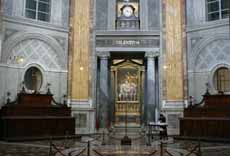| Grottoes
Vatican City Maps Colonnade Saints Floorplan #2 |
|
Related Items |
| Related
Links Vatican State-Treasury Elizabeth Lev article York Chalice Orbis Catholicvs |

|
Hours of Treasury:
|
 |
 |
|
|
| 1.
Entrance from the basilica
2. List of Popes Buried in St Peter’s 3. Connecting Room with the Corridor 4. Statue of Josemaria Escriva - Opus Dei 5. Corridor of the Treasury Museum 6. Museum Entrance - Gift Shop 7. Column from Constantinian Basilica 8. Chapel of the Beneficiaries 9. Dalmatic of Charlemagne 10. Monument of Sixtus IV 11. Treasury Museum Rooms 12. Sarcophagus of Giunio Basso |
13.
Chapel of the Sacristy Comune
14. The Sacristy 15. Corridor to the Sacristy 16. The Staircase of Honor 17. Statue of Pius VI 18. The Sala Capitolare 19. The Sacristy of the Canons 20. The Chapel of the Canons 21. The Corridor to the Choir 22. Piazza Bracchi 23. Statue of St. María Josefa (Entrance to Necropolis-Exit from Grottoes) |
From:
'St. Peter's - Guide to the Basilica and Square'
In the left aisle, under the monument of Pius VIII, is the entrance to
the sacristy. Is is a building which was attached to the basilica under
Pius VI who commissioned Carlo Marchionni (1702-1786) to build it in 1776.
On the right o the entrance, is a list o the popes buried in St. Peter's
and a statue of St. Andrew in polychrome marble, and then a gallery, decorated
with columns of the rarest marbles and bronze busts of Benedict XIII and
Paul IV by Agostine Penna. The main Sacristy, which is octagonal, is decorated
with eight columns from Hadrian's Villa in Tivoli.
From the sacristy, the ten rooms which house the Treasury can be visited. Worthy of note are: the fourth-century twisted marble column, decorated with vine tendrils; the gilded-medal cock, which formerly adorned the bell tower of old St. Peter's; the Chair of St. Peter, a copy of the oak throne which Charles the Bald presented to Pope John VIII in 875; the Dalmatic, said to have belonged to Charlemagne, but which is in fact an 11th century Byzantine masterpiece; the red cope and the tiara embellished with precious stones, which are put on the statue of St. Peter in the central nave for important solemnities; the Stuart chalice; the Crux Vaticana, made of leather studded with silver and precious stones and which contains fragments of the cross of Jesus; numerous reliquaries and valuable candelabra; a plaster cast of Michelangelo's Pieta made in 1934-35, thanks to which it was possible to restore the original perfectly after it was vandalized in 1972; the funerary monument of Sixtus IV, founder of the Sistine Chapel and the Apostolic Library, sculpted by Antonio del Pollaiolo. One of the most important sources of documentation of the art and faith of Christians in first-century Rome is the Sarcophagus of Junio Bassus, a noble and prefect of Rome, and a convert to Christianity. The marble sarcophagus, a fourth-century work, is carved with reliefs showing scenes from the Old and New Testaments.
From: 'Holy Year
2000 The Great Jubilee' © 1999 Lozzi Roma
Treasury of Saint Peter's
Room I - There are a red cope with tiara decorated with stones (XVIII century) destined to cover the venerated Saint Peter's statue of bronze, placed in the middle nave of the Basilica, in occasion of the solemn festivities; the so-called Stuart Chalice, itself belonging to the XVIII century, in gold and silver with 130 mounted brilliants.
Room II - There are exposed some of the most precious works, among which the Crux Vaticana (Vatican Cross) covered with silver leather and precious stones, containing fragments of the real Cross; the Dalmatix (liturgic vestment) erroneously called Charlemagne, since it belongs to a later age, more or less around the XI century according to some scholars, and around the XIV century according to others; numerous precious shrines.
Room III is dominated by the bronze monument to Sixtus IV (1471-84), a masterpiece by Antonio del Pollaiolo.
In Room IV is the 14th century frame of Veronica which used to hold the precious relic pressed between two sheets of glass.
In Room V the visitor can see copper spheres used as hand-warmers in the chilly sacristies, as well as a collection of precious chalices and reliquaries.
In Room VI, a vast collection of candelabra is exhibited. The small room that forms the corridor contains large sacred codices.
Room VII contains a model of one of the worshipping angels, made in clay and cast in bronze by Bernini for the Chapel of the Sacrament.
Room VIII displays a collection of vestments, sacred objects and votive jewels donated to the pontiffs by the faithful from all over the world.
In Room IX contains
an example of paleo-Christian sculpture, the sarcophagus of Junius Bassus
(4th century)
This independent website is not endorsed by or associated with the Vatican, the Fabbrica of St. Peter's, or any business organization
Contact: stpetersbasilica@gmail.com
